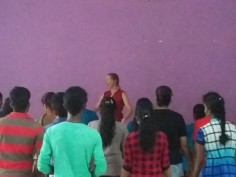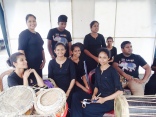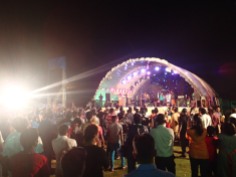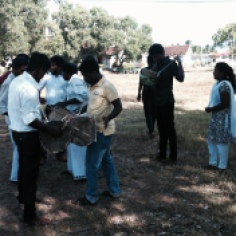Archive for the ‘sri lanka’ Tag
Access All Areas: Researcher
The Galle Music Festival was an intense whirlwind of activity. For me it started with the “Inspiration” workshop that Sevalanka asked me to lead – this was a session for all the artists the day before the Festival, designed to welcome them and get them interacting and relaxing together. Some of them had been travelling many hours and Galle Music Festival would be their first major event. They were tired, very serious, and not sure what to expect from it all. But the games and creative tasks I introduced worked a treat, getting them singing, clapping, sharing rhythms, songs, and other musical ideas from their traditions and their imagination, as well as laughing and connecting with each other.
Then there were soundchecks for me to do. I’d spent the last few days observing a drumming collaboration between two all-female drumming groups (one from the North, one from the South), and I’d ended up being roped in to play as part of the act. That was enormous fun, and a very different way to connect with the musicians in the group than simply as an outside observer.
The Festival began with the Morning Program, held in a lovely market square in Galle where a weekly artisan market is held. Stalls were created for the different performing groups where they could display their instruments and costumes, and they gave informal performances in front of their stalls or on the small stage at one end of the market square. The Morning Program at the market had a lovely, chilled vibe, and I was happy to see that it also gave the musicians a chance to interact with each other a bit more, check out each other’s instruments, performances, and so on.

It’s hard to see what is happening in this picture – but she is balancing her head-dress while crouching down to get eye level with the tomato. There is a NEEDLE stuck in the tomato. She then blinks the needle out with her EYE-LID! This was an uncomfortable trick to watch, didn’t look so comfortable to do either.
At the Festival I had two particular researcher tasks – I had a small team of volunteers to help me administer an Audience Survey, and I remained backstage throughout the evening concert to ask each group of performers to complete Performer Surveys. This meant that I was part of the energy and excitement of the performers, as they gathered at the side of the stage waiting for their turn, and afterwards, as they milled about, buzzing with adrenaline, but also (for many) rushing to get their equipment together and their costumes packed away in order to start their long journeys home as soon as possible.
I therefore never really got to see the Festival from the audience’s perspective. That night, it started raining heavily (in fact the rains that came continued unabated and were the cause of Sri Lanka’s devastating floods just a few days later), so the audience was mostly seated further back from the stage under weather-proof awnings. I wonder how it was for them, seeing these performers of diverse folk traditions, many of whom were only experienced in performing for rituals in their own communities? There was an impressive amount of elaboration. I loved these leopard costumes, from a folk theatre group from Mullaitivu District.

Unfortunately I couldn’t get a photo where he turned to look directly at me – but you can get a sense of the detailed face-painting from this shot hopefully.
My role backstage, and following on from the ‘Inspiration’ workshop on Friday, enabled me to interact closely with all of these musicians. After attending my workshop, many of the artists greeted me warmly when they saw me backstage, wanted to chat and to have photos taken with me.
Some of the groups that I’d spent quite a lot of time with – like the all-girl drumming group from Kilinochchi – were particularly sad to say good-bye. One of the girls gave me her pottu (Tamil word for the forehead decoration). We’d first met about 7 weeks earlier, when I came to see one of their village performances and interviewed them about their experiences in the previous year’s festival.
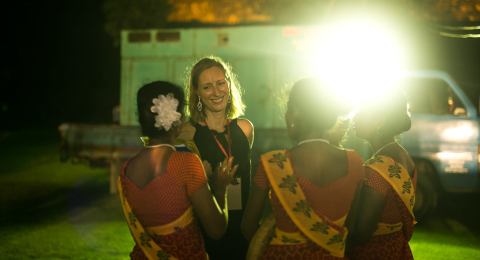
In the end, I had a satisfying amount of Audience Survey completions, and an even more pleasing number of Performer Surveys. My backstage pass for the Festival said “Researcher” on it, which was a definite highlight of my whole time in Sri Lanka! How many researchers can boast such Rock Star-like validation?

Access all Areas: Researcher
The Paraiyers’ drums
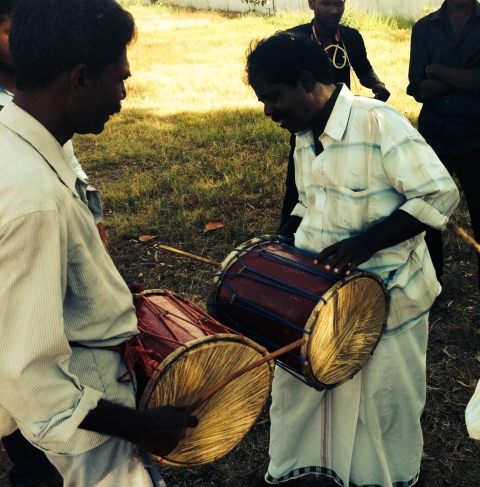
Another part of the Sri Lanka Norway Music Cooperation is the ‘village level performance’ program. Village-level performances give village elders that are custodians of rare and endangered folk forms (music, dance and theatre) support to put on a performance of their traditional work. Support can include funds to purchase instruments, for artist rehearsal time, to prepare costumes and props, and travel costs. This year, one of the village-level performances was in the Eastern province near the city of Batticaloa, and involved musician elders from four different villages.
The model that was used this year was particularly interesting. The musicians were all performers of the Parai drum tradition, which has for a long time been regarded as the instrument of the low-caste Paraiyers (see here for an interesting history of the Paraiyers). Because of this, members of the Paraiyer caste often reject this musical tradition, seeing the drum and its rhythms as markers of lowly status, and indeed, a marker of membership of that caste. Yet the musicians involved in this year’s village-level festival are adamant that the traditions and instruments should be preserved, and they have continued to play for rituals (usually funerals) despite the dismissive and often hostile responses from others in their community.
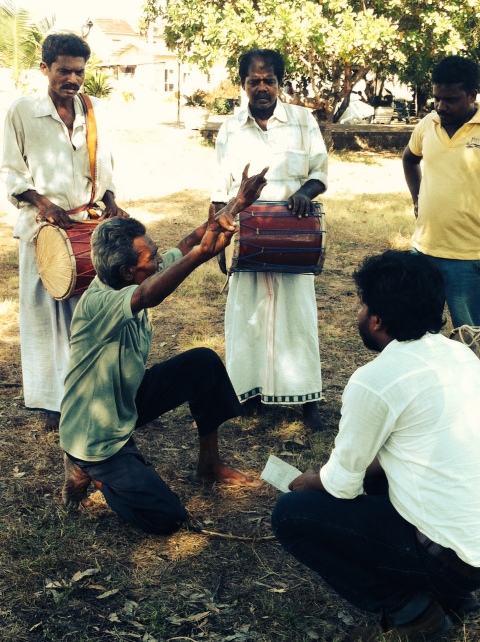
Therefore, building up the status and importance of the parai drum, and recognizing the work of the elder musicians in preserving it was one objective of the village-level festival. The next objective was to increase knowledge of the drum and its rhythms among young students of Tamil music. The Swami Vipulananda Institute of Aesthetic Studies (SVIAS) at Eastern University was a co-presenter of the village-level festival, and arranged for the elder-musicians to rehearse at the university each day in the weeks leading up to the performance. Students and lecturers of Tamil drum and dance worked with them closely, studying the artform. They worked outdoors, under big trees with a circle of benches surrounding the rehearsal space.
Bringing it into the University was a new initiative for the Music Cooperation, but it served two purposes – of helping to preserve and celebrate the knowledge of the elder musicians by training the next generation of performers, and of sidestepping the hostility towards the Parai drum within the musicians’ own communities.
I was able to observe two days of rehearsals during my research trip to Batticaloa two weeks ago, and these photos are from that visit. I saw a fascinating level of exchange taking place between the elders, the students, and the lecturers. Sometimes it was hard to see who was the authority, or the director of the project. One of the students explained it to me this way:
The elders are the experts in how to play this drum. They know all the rhythms and techniques and forms, and the students are eager to learn this from them. However, they have only performed for village rituals up until now, and they are not experienced in creating a performance for the public. So the students and the lecturers are contributing those ideas.
It reminded me that finding the balance between support and instruction, agency and collaboration, the authority of knowledge and the authority of institutions, and when to be expert and when to step back and give space for the content to emerge and evolve, is complex, messy, and somewhat infinite and imperfect pursuit. This project was tackling these challenges in what seemed to me to be courageous and thoughtful ways. I’m sure they all learned a great deal, and for me, it was an intriguing and thought-provoking process to observe.

Music development as reconciliation?
I’ve clarified the shape of my research project this last week. After feeling initially stalled by the idea of examining music activities that were created as music development activities rather than peace and reconciliation activities using music (so many variables! so open-ended!), I came to realize that the question to be answered is about the relationship between music development (the strengthening and development of the skills of different sector actors) and peace and reconciliation in Sri Lanka. Are the music activities having an impact? If so, where, and how, and what are the indicators of this, according to the people taking part? How do these vary across different subgroups of participants?

The connective logic or ‘theory of change’ that can be inferred from the activities goes something like this:
- Sri Lanka’s music sector (including traditional arts practices and the local (professional) music industry) has suffered great damage through the three decades of war.
- By building the capacity of musicians, supporting professionals (e.g. event organizers, audio engineers, lighting designers), and up-and-coming talents (through mechanisms such as performance opportunities, provision of resources such as instruments, training workshops, event experience, etc) you’ll raise the status of the music, and create more engaging and attractive gigs and events. You’ll also facilitate meeting, friendships, and potential collaborations between people of like minds, skills, and interests who have been divided through the recent war.
- As the events become more professional, they will attract people from all cultural groups who will be attracted by the music on offer and to the idea of spending time in a safe, depoliticized space that facilitates meetings with people of other ethno-religious groups.
- The performances of traditional music are also a platform for recognising all that is shared across the different cultures, as well as the value and interest of diversity. Performances and workshops are conceived as ‘culture learning’ platforms, where people can learn about other groups in a holistic way that encourages appreciation and engagement.
- The combination of culture learning and meeting in depoliticized spaces, and the potential for new intergroup friendships and collaborations to be made mean that the Music Cooperation’s impact could also be considered in terms of building peace and reconciliation in Sri Lankan society. However, this potential outcome is somewhat speculative as it has not been sufficiently tested or scrutinised.
Initially I thought that the Contact Hypothesis (from Allport 1954, utilized by social psychologists frequently since then, and further developed through multiple iterations; Arild Bergh used it very effectively as an analysis tool in his 2010 thesis examining music and conflict transformation) would be a useful framework. Contact theory posits that mere contact is not sufficient for reducing prejudice. Certain conditions relating to the context of the contact act as ‘facilitating conditions’, so that mere contact becomes optimal contact. However, a drawback with contact theory is that, over time, the number of facilitating conditions has increased to the point where the actual contact experience bears little resemblance to the conditions that govern the more banal intergroup contacts that are likely to take place in everyday life.
Furthermore, definitions of ‘reconciliation’ and ‘peace’ are undoubtedly contested. People with vastly different lived realities (e.g. those living in the most war-affected locations, or belonging to minority groups) are likely to have differing ideas of what these ideals look like in their lived experience – so whose definition should be used when considering how the music activities have impacted peace and reconciliation in Sri Lanka? Grappling with these questions has led me to a research design that lets the research participants (performers in the annual festivals, primarily) define peace and reconciliation at the outset, and then invites them to explore how – if at all – their lived experience of intergroup interactions, co-existence, and cooperation might have changed through the Music Cooperation activities.
The goals of the research are pragmatic. I hope to identify the key mechanisms and indicators for whatever changes are reported, so that this can inform and shape monitoring and evaluation. There will be other outcomes as well – such as building the evidence base that informs the program logic or theory of change (we may find we need to modify it accordingly). Also, the design allows for unexpected outcomes – things that are not currently part of the picture, but that are of importance to the participants, and therefore could be considered in future Music Cooperation programming.
Meanwhile, Colombo remains hot, hot, hot. Sometimes, travelling home on the bus at the end of the day, I make a mental list of ‘essential’ things I need to buy from the supermarket, just so that I can go and stand in the icy coolness of the local Food City for a few minutes to cool down and just not feel hot. They tell me it is only going to get hotter, these next few months. It’s the best reason I can think of to never buy groceries in bulk.
References:
Allport, G.W., 1954. The nature of prejudice, Cambridge, Mass : Addison-Wesley Pub. Co
Bergh, Arild. (2010). I’d like to teach the world to sing: Music and conflict transformation. (PhD dissertation), University of Exeter.
Dixon, J., Durrheim, K. & Tredoux, C., 2005. Beyond the Optimal Contact Strategy: A Reality Check for the Contact Hypothesis. American Psychologist, 60(7), 697- 711.
New project – music and reconciliation in Sri Lanka
At the end of last year I was awarded one of the Australian Government’s Endeavour Research Fellowships to develop a research project examining music development activities as a vehicle for reconciliation in Sri Lanka. Fast forward a couple of months and here I am in Colombo, sitting in a small apartment in a seaside suburb, getting my research project off the ground.
I’ve been here a little more than a week now. In that time, I’ve stayed in a guest house in the seaside suburb of Mount Lavinia, flat-hunted in two different suburbs eventually moving into a flat in Dehiwala, jogged on the beach at sunrise several times, eaten different varieties of rice and curry on a daily basis, attended a Carnatic Music Festival and a performance by the Symphony Orchestra of Sri Lanka, and joined the masses at the February Full Moon Perahera (Procession) Gangaramaya Temple in central Colombo. I’ve also had long conversations with colleagues here, mapped my way through the different activities that make up the Sri Lanka Norway Music Cooperation [SLNMC], and begun to scope out what the research project should include.
The Sri Lanka Norway Music Cooperation is, of course, the reason I’m here. It’s a partnership between Concerts Norway and Sevalanka Foundation in Sri Lanka that aims to revive and support traditional music practices, build practical and logistical skills among music industry professionals to raise standards of live performance (for example, supporting the skills development of audio and lighting personnel, music event management professionals, and field recording producers), and engage different sectors of society in music participation. The flagship events of the Music Cooperation are the Jaffna (in the north) and Galle (in the south) Music Festivals, held in either city in alternate years. The festivals attract tens of thousands of visitors, and gather together traditional and contemporary music performers from across the country. Other Music Cooperation activities include workshop programs in universities, a Children’s Festival, training for the next generation of folk musicians (i.e. children) to encourage them to feel proud and excited by the traditional instruments, music and dances of their local area and ethno-religious heritage, a radio program, development of a comprehensive online music archive, and partnerships with three national orchestras (symphony, youth, and oriental) based in Colombo.
So where do peace and reconciliation come into this program of music development? Anecdotally, in all sorts of ways – through the opportunities it provides for performers from around the country to be exposed to each other’s traditional practices and instruments, to present their music to diverse audiences, meet in safe, welcoming, and depoliticized spaces, and importantly, the chance to talk and potential form friendships and collaborations. For audiences, it is in the cultural learning, and the demystifying of the ‘other’ (for during the three decades of civil war, the northern and eastern parts of the country became increasingly cut off and isolated from the capital city, central, western, and southern provinces). The different activities have not necessarily been designed to explicitly address peace and reconciliation needs — they are music activities first and foremost, and they have broad appeal for this reason. But participants and organizers alike feel they have witnessed and experienced positive changes in intergroup relations during the 7 years (so far) that the Music Cooperation has run, and there is a pressing need to examine more critically what impacts the program may be having on reconciliation between country’s divided communities.
And that’s where I come in. My role is to document the changes taking place in peace and reconciliation outcomes, as experienced by participants and organisers across the range of SLNMC activities. I’ll be developing research tools to best capture these changes and also allow for unexpected changes and outcomes so that we get a multidimensional picture of the different ways these music activities may impact people’s lives. I’ll then write a report that can inform future NSLMC activities and establish the baseline for future program evaluations. I’ll be doing this alongside my PhD work which examines music schools in post-conflict countries. There are lots of contextual similarities but also anomalies, and I’m curious to see if and how the emergent themes from my PhD research might play out here.
That’s the broad brushstroke picture of what’s planned; we are now working to narrow down and tighten up the scope. I am only in Sri Lanka for three months (I’ll be doing the write-up in Norway when I am there end-May to mid-July). One very interesting development that I learned of this week is that the presentation I gave for Bangladesh Music Week (at the invitation of Concerts Norway) in November last year on music, human rights, and conflict resolution has inspired a group of students from the University of Peredeniya (Kandy) to initiate a research project on their Music Cooperation activities using Allport’s contact hypothesis as a framework (this was one of the theoretical frameworks I introduced in my presentation). Hopefully I’ll be able to work with them to shape this project and include it as a component of my research.
This is my first blog post in many months, and that is largely because life took so many unexpected turns for me in the last 6 months. Sitting here in my airy (but still hot) little apartment, ceiling fan spinning reassuringly overhead, hearing neighbours call to each other in the street below, my stomach full from the egg hopper with caramelised onion sambal I ate for my dinner, thinking about the project ahead, and the PhD, and the whirlwind of events that have made up my life over the last 6 months, I find I keep thinking, “Wow. What a life!” And what a privilege, to get to engage with things you really care about (music, and social justice) in such diverse and fascinating places. Here goes! More soon.
 Leave a comment
Leave a comment
